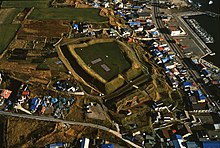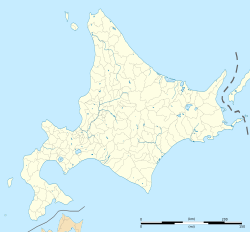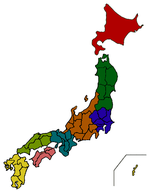Shinoridate

志苔館跡 | |
 Aerial view (courtesy of Hakodate City) | |
| Location | Hakodate, Hokkaidō, Japan |
|---|---|
| Coordinates | 41°45′57″N 140°49′20″E / 41.765825°N 140.822251°E |
| Altitude | 17 to 25 m (56 to 82 ft) |
| Type | Fortified residence |
| Length | 50 to 65 metres (164 to 213 ft) |
| Width | 70 to 80 metres (230 to 260 ft) |
| Area | 4,100 square metres (44,000 sq ft) (enclosure) 19,960.14 square metres (214,849.2 sq ft) (Historic Site) |
| Site notes | |
| Ownership | National Historic Site |
| Public access | Yes |
The site of Shinoridate (志苔館跡, Shinoridate ato) in Hakodate, Hokkaidō, Japan, is that once occupied by the Shinori Fort or Fortified Residence (as denoted by the tate or date ending). This was the easternmost of the so-called "Twelve Garrisons of Southern Hokkaido", built on the Oshima Peninsula by the Wajin from the fourteenth century.[1][2] The site was designated a National Historic Site in 1934 and is one of the Japan Castle Foundation's Continued Top 100 Japanese Castles.[3][4]
Shinori fort
[edit]

Shinoridate is located some 9 kilometres (5.6 mi) to the east of the center of Hakodate, along a stretch of coast with many good natural harbours. A short distance inland from Shinori Fishing Port, with the mouth of the Shinori River to the west, the gently sloping site overlooks the Tsugaru Strait and Shimokita Peninsula, with views also towards Mount Hakodate.[1][7]
The earthworks rise to a height of 4 to 4.5 metres (13 to 15 ft) on the north side and 1 to 1.5 metres (3.3 to 4.9 ft) to the south and are interrupted by an opening on both the east and the west sides. The moat is 5 to 10 metres (16 to 33 ft) wide on the north and west sides and up to 3.5 metres (11 ft) deep and is crossed by two earth bridges, that to the west particularly well-preserved.[1][7]
First laid out around the end of the fourteenth century, Shinoridate features in the Matsumae Domainal history Shinra no Kiroku, which tells of it being sacked by the Ainu in Chōroku 1 (1457), during Koshamain's War, and again falling to the Ainu in Eishō 9 (1512), after which its occupants, the house of Kobayashi (小林氏), became subject to the Matsumae clan.[1][note 1]
The Hakodate City Board of Education conducted excavations and surveys of the enclosure and surrounding area between 1983 and 1985, uncovering the remains of a number of buildings, palisades, a well, artefacts made of bronze, iron, stone, and wood, celadons and white porcelain from southern China, as well as domestic Suzu, Echizen, and Seto ware.[1][7][8]
Three different intercolumnar measurements were used in the construction of the buildings, the style of the well is that found in Heian-kyō in the late Kamakura period, while many of the ceramics are typical of the early fifteenth century.[7]
Accordingly, three main phases have been identified: the end of the fourteenth or early-fifteenth century; mid-fifteenth century; and sixteenth century or later. With the archaeological evidence pushing back the origins of the fort at least half a century before Koshamain, its construction can no longer be understood as an immediate response to the contingencies of 1457, and other explanations are required.[7]
Shinori hoard
[edit]
In July 1968, during widening work on the prefectural road (now National Route 278) that runs past the fort, a Nanbokuchō-period (C14) coin hoard was unearthed some 40 metres (130 ft) inland from the mouth of the Shinori River, at a location 3 metres (9.8 ft) above sea level. This is the largest hoard found to date in Japan in terms of the number of coins it contains.[7]
The three large vessels excavated weighed, together with their contents, 1.6 tonnes (1.6 long tons; 1.8 short tons). Ninety-three different types of coin have been identified: a handful in total of early Japanese coinage of the Asuka, Nara and early Heian periods, late tenth-century Vietnamese coinage of the Đinh and Early Lê dynasties, and late eleventh-century Goryeo coinage from Korea; the bulk comprising Chinese coinage, primarily of the Song dynasty, issues ranging in date from 4 Zhu Ban Liang minted in the fifth year of Emperor Wen of Han (175 BC) to Hongwu Tongbao from the first year of the Hongwu Emperor, founder of the Ming dynasty (1368).[7] The 374,435 coins from this hoard now at the Hakodate City Museum have been designated an Important Cultural Property.[9]
A 1999 study of 275 Japanese hoards, totalling 3,530,000 coins, found that the Chinese copper coins used in Japan in the Middle Ages were brought over in the largest number in the thirteenth century, were used primarily in commerce or for paying soldiers, and were buried largely for reasons of security, although there were also instances of ritual or votive deposits.[10][11] The dating of the Shinori hoard precludes its burial as a response to Koshamain's War; instead it may relate to trade, the local Shinori or Kaga kombu featuring alongside Ezo salmon in the Nanboku-chō period text Teikin Ōrai (庭訓往来). Produce from the area would have been traded along the Hokuriku coast to reach the markets of Kyōto and Ōsaka.[7]
See also
[edit]- List of Historic Sites of Japan (Hokkaidō)
- List of Cultural Properties of Japan - archaeological materials (Hokkaidō)
- Hakodate City Museum
- Shiryōkaku
- Shakushain's revolt
- Chashi
- Kitamaebune
- National Ainu Museum
Notes
[edit]- ^ 「長禄元年五月十四日夷狄蜂起来而、攻撃志濃里之舘主小林太郎左衛門尉良景…殺狄之酋長胡奢魔允」("On the fourteenth day of the fifth month of the first year of the Chōroku era (1457), a barbarian uprising occurred, and in an attack on Shinori Fort, its lord Kobayashi Tarō Saemon-no-jō Yoshikage...was killed, the barbarian tribal leader being Koshamain") 「永正九年四月十六日宇須岸志濃利與倉前三舘所攻落夷賊…小林太郎左衛門尉良景之子彌太郎良定」("On the sixteenth day of the fourth month of the ninth year of the Eishō era (1512), the three forts of Usukeshi, Shinori, and Yokuramae fell in an attack by barbarian bandits and...Kobayashi Tarō Saemon-no-jō Yoshikage's son Yatarō Yoshisada was killed")
References
[edit]- ^ a b c d e 史跡志苔館跡 [Shinoridate Site - Historic Site] (in Japanese). Hakodate City. Retrieved 9 September 2019.
- ^ 史跡志苔館跡 [Historic Site: Shinoridate] (in Japanese). MLIT Hokkaido District Transport Bureau. Retrieved 9 September 2019.
- ^ 志苔館跡 [Site of Shinoridate] (in Japanese). Agency for Cultural Affairs. Retrieved 9 September 2019.
- ^ 続日本100名城 [Continued Top 100 Japanese Castles] (in Japanese). Japan Castle Foundation. 29 November 2017. Retrieved 9 September 2019.
- ^ Itō Norihiko (伊東則彦); Hamada Tsuyoshi (經田剛) (1 August 2019). 上ノ国物語1 -コシャマインの戦い- [Tales of Kaminokuni (1): Koshamain's War]. Hokkaido Medical Journal (in Japanese) (1211). Hokkaido Medical Association.
- ^ Batten, Bruce Loyd (2003). To the Ends of Japan: Premodern Frontiers, Boundaries, and Interactions. University of Hawai'i Press. p. 110. ISBN 978-0824824471.
- ^ a b c d e f g h i Tahara Yoshinobu (田原良信) (31 March 2004). 再考志海苔古銭と志苔館 [Rethinking the Shinori Hoard and Shinori Fortified Residence] (PDF). Research Bulletin of the Hakodate City Museum (in Japanese) (14). Hakodate City Museum: 9–20.
- ^ 史跡志苔館跡 [Historic Site: Shinoridate] (in Japanese). Nara National Research Institute for Cultural Properties. Retrieved 9 September 2019.
- ^ 北海道志海苔中世遺構出土銭 [Coins excavated from the medieval remains of Shinori, Hokkaidō] (in Japanese). Agency for Cultural Affairs. Retrieved 9 September 2019.
- ^ Suzuki Kimio (鈴木公雄) (1999). 出土銭貨の研究 [The dynamics of money circulation in 14th to 18th Century Japan]. Tokyo Daigaku Shuppan Kai. ISBN 978-4130260688.
- ^ Pearson, Richard J (2016). "Japanese medieval trading towns: Sakai and Tosaminato" (PDF). Japanese Journal of Archaeology (3). Japanese Archaeological Association: 89–116.
External links
[edit]- Shinoridate (in Japanese)


